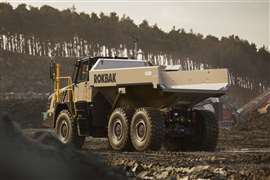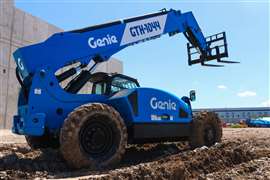Major cities make push on electric construction equipment
11 February 2022
With the cities of Oslo, Copenhagen and Helsinki attempting to pilot the world’s first zero-emissions construction sites, Lucy Barnard finds out how pressure is mounting on contractors across Europe to switch to electric.
When construction work started at Olav V Street in the centre of Norwegian capital Oslo, the noise and fumes created by excavators digging up the road to convert a taxi rank into a pedestrianised zone was so low that café owners even left their doors open.
So says Guro Wensaas, social responsibility advisor at Oslo Municipality, the city government responsible for attempting to undertake the world’s first zero emissions construction project.
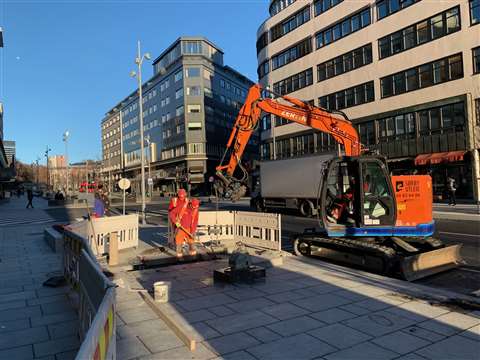 Workers put finishing touches to a novel ‘zero-emissions’ building site in central Oslo, November 2020 Photo: Alister Doyle, Reuters
Workers put finishing touches to a novel ‘zero-emissions’ building site in central Oslo, November 2020 Photo: Alister Doyle, Reuters
Work began on site in one of the busiest streets in the city in September 2019 and completed in November 2020, using nearly all electrical machinery.
“The pilot project in Olav Vs gate has produced valuable experience for future projects, both for contractors, grid companies, municipalities and machine suppliers,” says Marianne Mølmen, Project Manager for zero-emission construction sites.
“The City of Oslo has willingly accepted its responsibility for bringing about the necessary changes in the emission levels from the building and construction industry, so that we can enjoy a greener city.”
Much of the work was completed using a ZE85 9-tonne battery-powered tracked excavator and a ZE160LC excavator, developed by Hitachi in cooperation with Norwegian dealer Nasta and the German company EAC European Application Centre. Other electric machines used on the site included a Kramer 5055e wheel loader and a Caterpillar 323F Z-line excavator (developed by Pon.).
According to Mølmen, overall the electric machines performed equivalently to diesel ones but some processes still required traditional machinery such as welding in order to ensure the same quality.
Now, as a result of the success of the project, Oslo Municipality is aiming to require all contractors undertaking construction work on its behalf to use emissions-free equipment.
Zero emissions construction sites
The city is one of a small but growing number aiming to cut emissions from construction sites to zero over the coming decade through a combination of demonstrating best practices, public procurement incentives and changes to construction permit rules. (See box at bottom for list of case studies.)
According to the United Nations, 23% of the world’s CO2 emissions come from construction and 5.5% of that come from machinery and equipment on construction sites.
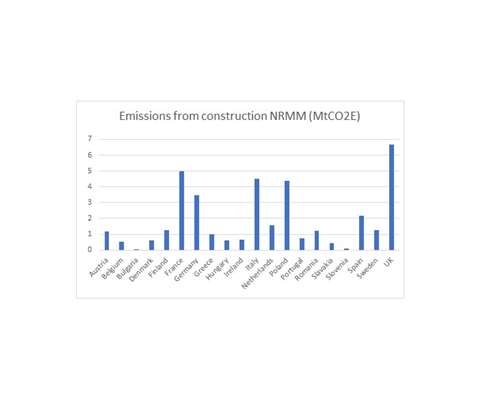 Construction Non-Road Mobile Machinery Emissions by country - source: UN Framework Convention on Climate Change
Construction Non-Road Mobile Machinery Emissions by country - source: UN Framework Convention on Climate Change
Over the last twenty years, many cities, especially those in Europe have introduced Low Emissions Zones (LEZ) regulating the number and type of diesel and petrol cars which can access city centres. However, most LEZs still do not include construction machinery and other off-road vehicles.
“As cities become increasingly aware of air pollution impacts and turn to ‘Low Emission Zones’ and alternatives, construction machinery has remained relatively unregulated,” says Mark Preston Aragonès, policy advisor at Norway-based non-profit organisation, The Bellona Foundation.
“Construction machines are frequently omitted from Low Emission Zones, which regulate the access and operation of vehicles within designated areas.”
Wensaas and Mølmen say that instead of restricting fossil fuel burning construction equipment through the city’s congestion charge or Low Emissions Zone, Oslo city council is hoping to use planning permits to completely ban emissions from construction sites by 2030.
Moreover, as a major purchaser of construction services for roads, schools, nursing homes and wastewater infrastructure, with a construction budget of NOK10bn (€1bn) a year, Oslo will use its purchasing power to require publicly procured construction projects to use zero emissions machinery and transport by 2025.
In 2019, the city even updated its procurement policies requiring projects worth NOK50m (€5m) to use zero emission heating and drying equipment, which is mainly used for curing concrete. And for projects worth NOK5m and above, contractors which specify the use of zero emissions machinery and/or heavy duty vehicles get preferred treatment.
As a result, Oslo estimates that around 15% of the new excavators sold in the city this year will be electric.
The Big Buyers Initiative for construction
Oslo is also one of a handful of cities in the Big Buyers Initiative working group on zero emissions construction sites – “Zemcons” for short. Cities which sign up for the project, run collaboratively by ICLEI (Local Governments for Sustainability) and Eurocities, have committed to use their buying power through public procurement contracts to drive innovation.
“Using their vast purchasing power, cities can create a new market and push manufacturers, contractors and suppliers to adopt new technologies and methods to enable the construction industry to continue its vital work without damaging our environments,” says Preston Aragonès.
The working group is primarily led by Oslo, Copenhagen, Helsinki and Stockholm, all of which are in various stages of piloting zero emissions construction sites. However, other European cities are watching closely, including Amsterdam, Brussels, Budapest, Lisbon, Nantes and Trondheim.
 London has a target of reducing emissions from construction sites to zero by 2040 - photo: Reuters
London has a target of reducing emissions from construction sites to zero by 2040 - photo: Reuters
In 2020, Denmark-based contractor Nordkysten started work on Copenhagen’s first zero emissions construction site, laying cables under the city’s pedestrianised Østergarde area.
The contractor used equipment including Wacker Neuson’s 1.5 t EZ17e excavator, a 1.5 t payload electric DW15e wheel dumper, a battery-powered vibratory plate AP1850e, and a battery-powered rammer AS50e, rented from Denmark’s largest rental company, GSV.
“When we work a lot in night-time, we have to use machines with very low noise,” says Frank Schou Kruse, managing director of Nordkysten. “The machines are impressing us a lot.”
And in 2021, Finnish capital Helsinki completed its first major public project using electric construction equipment, converting Kulosaaren puistotie boulevard in the Kulosaari district, into a cycling street.
The construction work, which was undertaken by Finnish contractor VM Suomalainen Oy, used three 4.2 t electric wheel-excavators and one electric mini-excavator. However, the rest of the machinery used on site was diesel-powered, with most of these machines fuelled with HVO (hydrotreated vegetable oil).
The city’s Urban Environment Division said that it had decided not to demand full use of electric machinery on the site because it wanted to let small companies which could not afford electric machinery to participate in the tendering whilst still encouraging the use of electric machinery.
Helsinki aims to be fossil fuel free by 2025
As a result of the project, the council said it has decided to apply the minimum criteria for this procurement for all future outsourced infrastructure and street infrastructure projects. It plans to make all city construction sites fossil fuel free by 2025 and zero emissions by 2030.
“With the Green Deal signed in September 2020, the practices of zero-emission worksites will be gradually applied to the work of the entire city,” the Urban Environment Division said in a statement. “Next we will expand the pilots to housing construction and maintenance projects.”
On the other side of Europe, London too has announced it plans to bring construction site emissions down to zero, but only by 2040.
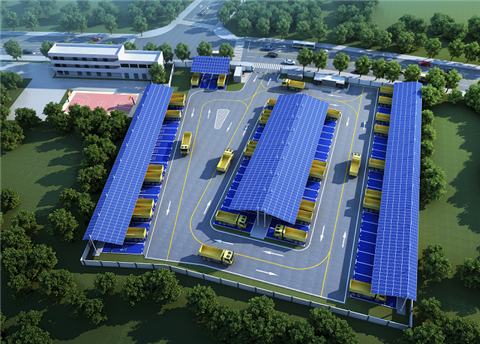 The city of Shenzhen has become the showpiece for China’s push into electric vehicles and already operates fleets of electric busses and taxis. In May 2020, the city started construction of the country’s first large scale vehicle charging station with capacity to charge 600 electric waste collection trucks. By the end of 2020 Shenzhen reported that there were more than 3,700 electric trucks operating in the city. (Photo: China Southern Power Grid)
The city of Shenzhen has become the showpiece for China’s push into electric vehicles and already operates fleets of electric busses and taxis. In May 2020, the city started construction of the country’s first large scale vehicle charging station with capacity to charge 600 electric waste collection trucks. By the end of 2020 Shenzhen reported that there were more than 3,700 electric trucks operating in the city. (Photo: China Southern Power Grid)
However, unlike Oslo, Copenhagen and Helsinki, the London Mayor is hoping to achieve the switch by introducing its own Low Emissions Zone for non-road mobile machinery which it is putting into practice through the use of planning conditions and enforcing through site inspections.
The NRMM (Non-road Mobile machinery) Low Emissions Zone requires all operators to register and for all equipment used in the areas in which it operates to meet specific EU emissions standards.
And the Mayor’s office says that it is waiting for legislation from the UK government in order to do more.
“The Mayor has consistently lobbied for Government to create more efficient powers to control emissions from all NRMM in London,” a spokesman from the Mayor’s press office told Construction Europe.
“Despite the commitment made in the 2019 Clean Air Strategy Government has yet to bring forward regulations to help local authorities control emissions from this source.”
Equipment manufacturers, meanwhile, say that construction companies, rental companies and their clients are also requesting emissions free construction equipment in order to enhance their ‘green’ credentials.
In February 2021, for exaample, Austrian contractor Swietelsky used a Wacker Neuson electric mini excavator and battery powered rammer to complete outdoor facilities including a children’s playground, pavements and loading bays at a mixed use development in central Vienna.
“We would like to reduce CO2 emissions as well as noise pollution step by step, particularly in the inner city area,” says Karl Weidlinger, CEO of Swietelsky. “We can reduce operating costs with [these machines] and protect the operators even better.”
In France, civil engineering firm Colas said it was trialling a fully electric excavator at its Stonleigh Junction site in Warwickshire, UK.
Energy giant Shell, which is currently in the midst of a major construction effort to install 500,000 EV (electric vehicle) charging points across its sites - up from the current 80,000 points - says that it too hopes to run a trial of EV excavators in 2022.
Transition moving too slowly
Yet critics still complain that globally the transition to zero-emissions construction equipment is still moving too slowly.
Contractors and rental companies point out that prices for electric equipment is prohibitively expensive. Volvo CE, one of the world’s major construction equipment OEMs and a leader in electric machines, estimates that the average price of an electric mini excavator stands at around €63,600 (£53,000) while its diesel equivalent is just €25,200 (£21,000).
Without sufficient charging infrastructure, contractors fear that they would not be able to get enough power to do the work required. And, with electric construction vehicles still in their infancy, many fear that the equipment is not as powerful as its diesel equivalent.
“The shift to electrification is a chicken-and-egg scenario. If sales volumes of electric machines don’t rise, then the prices will struggle to fall,” says Mats Bredborg, head of customer cluster utility at Volvo CE.
“The leaders of major urban centers are sold on the idea of cleaner inner city construction, but it needs the entire supply chain - legislators, clients, contractors, equipment manufacturers - to make it a reality. At Volvo CE we are investing heavily in electrification, but the wider industry is proving resistant to updating entrenched construction methods.”
Bredborg believes that the electric vehicle revolution taking place around the world – and the massive infrastructure requirements that come with it - provides the perfect opportunity for city councils and customers to work together to demand the use of electric construction equipment too.
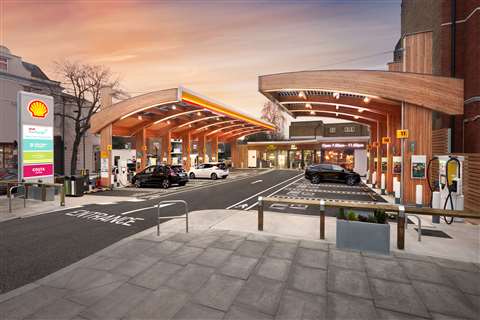 Shell’s first EV charging station in London, UK - photo: Shell, copyright Ed Robinson
Shell’s first EV charging station in London, UK - photo: Shell, copyright Ed Robinson
Market research firm Berg estimates that, as the number of electric vehicles in cities grows steadily, the number of connected EV charging points in Europe and North America is set to grow at a compound annual growth rate of 38% to reach 7.9 million in 2025.
Volvo’s Bredborg argues that the clients responsible for installing the millions of new EV charging points in city centres should make it a requirement that the contractors carrying out the work should use zero emissions equipment.
“Take the mass installation of charging points for electric vehicles,” he says. “Ironically, at the moment they are almost all being built using machines using diesel engines, with the noise and emissions that go with them.
“This is counterintuitive when there are electrical alternatives. It would be easy for city authorities or the power company that commissions the work to specify that contractors use emissions free equipment. At present this isn’t happening, and so old habits die hard.”
Bellonia’s Preston Aragonès, however, believes the solution must also lie with further legislation, both at a European and a national level.
Currently the European Union only places limits on the amount of diesel emissions produced by construction vehicle through the EU’s Non-Road Mobile Machinery regulations. Bellonia argues that for the EU to reach its aim of being carbon neutral by 2050, it must act quickly to set a goal for zero emissions construction machinery too.
“The [EU] NRMM regulation is clearly inadequate to fully address the scale of the human health and climate challenge with which we are faced,” says Preston Aragonès. “There is a need for policies which both push and pull the market towards cleaner technologies by creating a demand for cleaner machinery and curtail the use and production of ‘unclean machinery’ in line with Europe’s climate and air pollution goals.”
“We are calling on the relevant authorities at the city, regional, national and European levels, to go beyond the requirements of the NRMM Regulation and implement strategies which reduce air pollution and greenhouse gas emissions to zero,” says Preston Aragonès.
| City | Measures |
| Oslo, Norway | Oslo Municipality already requires contractors bidding for municipal tenders to be fossil fuel free. Oslo’s Climate Strategy says that from 2025 the municipality’s owns sites will be emissions free. It plans to use planning permits to completely ban emissions and diesel vehicles from construction sites from 2030 onwards. |
| Helsinki, Finland | The Finish government hopes to achieve 100% fossil fuel free construction sites by 2025 through a voluntary agreement with 20% emissions free. By 2030, the government wants all sites to be electric, hydrogen or biogas. |
| London, UK | London’s NRMM Low Emissions Zone requires all engines with a power rating between 37kw and 560kw to meet an emissions standard based on the engine EU emissions ‘stage’. The city has a target of zero emissions construction sites by 2040. |
| Copenhagen, Denmark | Copenhagen has already piloted a zero emissions construction site in the city centre. The city’s climate plan says it is prepared to implement procurement strategies focused on the construction sector. |
| Amsterdam, Netherlands | Amsterdam is planning on setting low-emission criteria in tenders with the aim of eliminating emissions from mobile machinery by 2025. The city is also investigating banning diesel generators in certain areas. |
| Stockholm, Sweden | Stockholm’s target is for the construction sector to be fossil-free by 2040. Since 1999, contractors bidding for public contracts must ensure engines meet specific emissions standards or be retrofitted |
STAY CONNECTED


Receive the information you need when you need it through our world-leading magazines, newsletters and daily briefings.
CONNECT WITH THE TEAM









